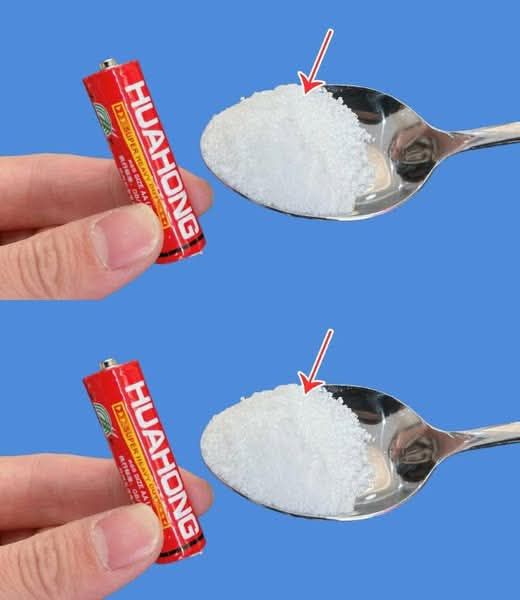ADVERTISEMENT
Instructions:
- Prepare the Salt Solution:
In a small bowl or container, mix about a teaspoon of Epsom salt (or regular salt) with a small amount of water. You want to create a saturated solution where the salt dissolves into the water but leaves some residue at the bottom. Stir it with a spoon or stick to make sure the salt is mostly dissolved. - Apply the Solution to the Battery Terminals:
Dip a cotton swab or cloth into the saltwater solution. Gently apply the mixture to the battery terminals (the metal contacts at both ends of the battery). You don’t need to soak the entire battery—just focus on the terminals where corrosion might have occurred. - Let the Solution Sit:
Allow the saltwater solution to sit on the terminals for a few minutes. The salt is working to break down any buildup or corrosion that may be blocking the electrical flow. - Dry the Battery:
After a few minutes, use a paper towel or soft cloth to wipe away any excess saltwater solution from the battery. Be sure to dry the terminals thoroughly to avoid any moisture remaining on the battery, as this could cause short-circuiting. - Test the Battery:
Insert the battery back into your device and test it. If the battery revival method worked, you should notice the device powering back on. Keep in mind that the revived battery may not last as long as a brand-new one, but it could give you enough time to use the device or replace the battery with a fresh one.
When Should You Use This Method?
While reviving dead batteries with salt can be a useful trick, it’s important to understand when it’s appropriate to try it:
- Minor Corrosion or Sulfation: This method works best when the battery has mild corrosion or sulfation. If the battery is leaking or has extensive damage, it’s likely no amount of salt will fix it, and you should dispose of it safely.
- Short-Term Boost: If you’re in a pinch and need a little more time from a battery, this method can help you eke out a bit more life. It’s not a permanent solution, and the battery will eventually need to be replaced.
- Alkaline Batteries Only: The salt method is most effective with alkaline batteries (AA, AAA, etc.). It’s not a good solution for lithium-ion or rechargeable batteries, which require a different set of techniques for reconditioning.
Why Is This Trick Worth Trying?
There are several reasons why this salt method has gained popularity among DIY enthusiasts and environmentally-conscious individuals:
- Eco-Friendly: Instead of throwing away dead batteries that might still have some life left in them, reviving them with salt can reduce waste. It’s a simple, sustainable way to get more out of your existing batteries.
- Quick and Easy: The method is incredibly simple and doesn’t require any special tools or technical knowledge. With just a spoonful of salt, you can try to bring a dead battery back to life in a matter of minutes.
- Cost-Effective: If you’re low on batteries and don’t have an immediate replacement, this method can save you the cost of purchasing new ones—especially if you just need a little more juice to power through.
- Interesting Science Experiment: For science enthusiasts or curious individuals, experimenting with salt and dead batteries is a fun way to learn about how electrical components work and how corrosion affects the functionality of batteries.
Potential Limitations and Risks
While this method is easy and effective in some cases, there are limitations:
- Temporary Fix: This revival method is usually a short-term solution. The battery won’t be restored to its original capacity, and it will likely lose power again soon. Think of it as a way to extend the life of a battery for a bit, not to fix it permanently.
- Not for All Batteries: This method only works on certain types of batteries, and it’s not suitable for those that have leaked or suffered significant damage.
- Not Always Effective: If the corrosion or sulfation is too severe, or if the battery is completely dead, the method may not work at all. In these cases, the battery should be safely disposed of.
Conclusion
Reviving dead batteries with just a spoonful of salt can be a handy and environmentally-friendly trick, particularly when you need a quick fix or want to extend the life of a battery that’s only slightly corroded. While it doesn’t work in every case, and the revival is often temporary, it’s a simple and cost-effective method worth trying. So, the next time you find yourself with a dead AA or AAA battery, don’t be too quick to toss it in the trash—grab a spoonful of salt, and you may just breathe new life into it!
